News
Unraveling the mysteries of the plant microbiome
Three years after joining the Great Lakes Bioenergy Research Center, Michigan State University microbiologist Sarah Lebeis has been tapped to guide the center’s scientific research.
Farmers can’t predict their annual corn harvest with certainty, but with the help of new research from Michigan State University, they can now pinpoint specific parts of their fields that consistently produce either good or bad yields. Not only will this save them time and money; it will solve one of the most widespread environmental problems facing crop-producing regions – nitrogen loss.
Microbial production of fuels and other useful chemicals offers renewable alternatives to products that are currently derived from fossil fuels.
You might think that mowing fields wouldn’t benefit monarch butterfly populations. New research from Michigan State University, however, shows that disturbances like mowing – at key times – might help boost the iconic butterfly’s numbers.
Jason Peters is one of thousands of scientists worldwide aiming to curb the impact of antimicrobial resistance, which is one of the World Health Organization’s (WHO) 10 threats to global health in 2019.
With a few genetic tweaks, a type of soil bacteria with an appetite for hydrocarbons shows promise as a biological factory for converting a renewable — but frustratingly untapped — bounty into a replacement for ubiquitous plastics.
Fossil fuels seep their way into almost every aspect of American life.
Transportation, heating and the plastics and chemicals we use every day all rely on petroleum products, but our insatiable appetite for fossil fuels will have catastrophic consequences for the health of the planet if left unchecked.
An insect’s gut might seem an inhospitable place to settle in, but diverse microbes nonetheless make their home there. Yet in the gut, there’s a struggle for the nutrients needed to survive among the resident bacteria and fungi — not to mention the insect.
Alex Linz has thousands of multi-talented, microscopic labmates.
“Why do I love microbes? I think it’s just crazy that they’re all around us, and we can’t see them, and yet if you can dream it up, microbes probably do it,” says the UW–Madison postdoctoral researcher.
Bioenergy crops are a potential source of renewable alternatives for many petroleum-derived products. Great Lakes Bioenergy Research Center (GLBRC) scientists at Michigan State University (MSU) have now devised a system to coax plants into producing higher amounts of two valuable organic materials, terpenes and lipid droplets, and package them together inside cells for easy extraction.





